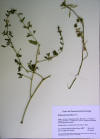|
Kallstroemia californica |
Kallstroemia hirsutissima |
|
Kallstroemia parviflora
|
|
|
Wilson, R. D., D. A. Witzel and J. M. Verlander. 1982. Somatosensory-evoked response of ataxic Angora goats in suspected haloxon-delayed neurotoxicity. Am. J. Vet. Res. 43(12): 2224–2246. “Somatosensory-evoked responses (SER) were recorded in 3 Angora goats with moderate posterior paresis. The cause of posterior paresis was unknown. The goats had recently been given haloxon and had also been grazing in a pasture with carpetweed (Kallstroemia hirsutissima). Haloxon and carpetweed have each been reported to cause posterior paresis in livestock. An electrical stimulus applied subcutaneously in the pelvic limb of the affected goats failed to evoke an SER at the cerebral cortex. Electrical stimulation in the thoracic limb evoked a normal-appearing SER. The absence of SER from pelvic limb stimulation indicated a functional impairment of the somatosensory pathways.” |
|






